| 1 | Fer-de-lance |
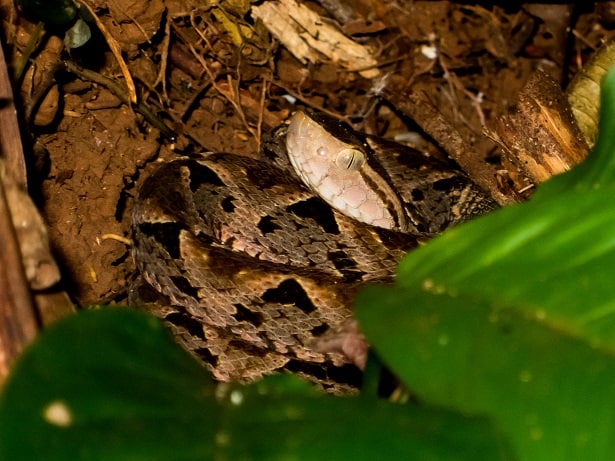
Known as Bothrops asper in Latin, the fer-de-lance is the most dangerous venomous snake in Central America, and Guatemala is crawling with them. This snake is so feared that Mayan civilisations positioned their settlements directly behind jungles, to force their warring enemies to walk past the snakes within.
Bothrops asper averages at 100-120cm, but the largest brutes can reach 250.1cm. Unpredictability is the most infamous characteristic of Bothrops asper. It’s possible for them to remain as still as a statue while you back off slowly, heart pounding like a jackhammer. But it’s also possible that they’ll pounce. Their accuracy rate while striking is near 100%, aided by heat-sensitive IR pits in their face. They can strike multiple times at a human target, with no need to coil up tightly and spring.
The fer-de-lance is a strongly nocturnal pitviper, almost never moving during the day. In their average nighttime session, they move less than 10 metres, between their resting spot and ambush position. Every so often though, they’ll move 50 metres at once, searching for more bountiful hunting grounds. Their diet consists heavily of mammals, which often draws them into banana plantations, with their high numbers of rats.
Bothrops asper inhabits a variety of forest types: tropical coniferous forests, rainforests, and cloudforests at elevations of up to 2600 metres. During the day, they’re commonly found sleeping beneath thick layers of leaves.
| 2 | Guatemalan milk snake |
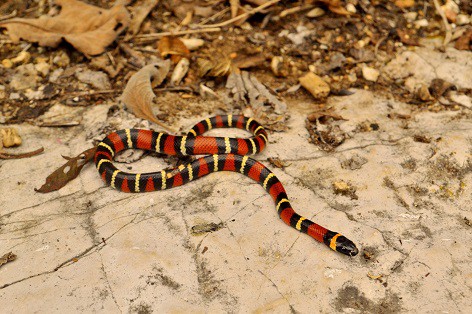
A relative of the US milk snake, which was split into its own species in 2014. The Guatemalan milksnake (Lampropeltis abnorma) lives in densely forested areas, and sticks to the ground. It’s also a naturally rare snake, which would be spread about in low numbers even if humanity had never existed.
Guatemalan milk snakes are typically 100-150cm, with an all-time record of 184cm. They’re naturally shy, hiding in rotten logs and hollows in the bases of trees. Consequently, Lampropeltis abnorma is rarely sighted by people. Most sightings come when they stray into agricultural areas directly adjacent to forests.
Lampropeltis abnorma is a constrictor, and has powerful squeezing abilities even as a 50cm newborn. One of their ID signs is a narrow, V-shaped band draped over their snout.
Guatemalan milk snakes dine on mammals, with one confirmed prey being Mexican deer mice. This species is particularly easy to confuse with the venomous coral snakes they mimic, as its face is pure black. Guatemalan milksnakes share the alternating band patterns of most milk snakes: red, black, pale, black, red and repeat, with red never touching pale. The pale bands are normally orange with the Guatemalan milksnake, darker than the Ecuadorian milk snake further south.
| 3 | Central American rattlesnake |
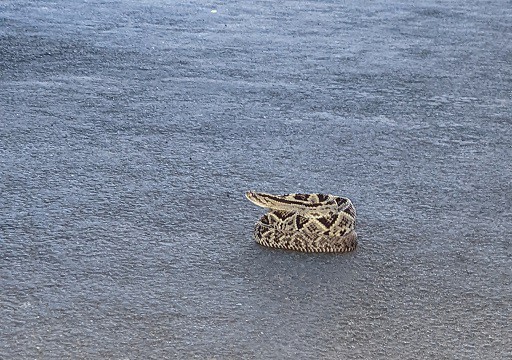
The ruling rattlesnake of far southern Mexico through to northwest Costa Rica. At 1.4 metres and a maximum of 1.8 metres, this is one of the longest rattlesnakes worldwide, easily outstripping such infamous US characters as the tiger or rock rattlesnake. For countries like Nicaragua and Costa Rica, this is the sole rattlesnake species, although Guatemala is also home to the less common Tzabcan rattlesnake.
Central American rattlesnakes (Crotalus simus) stay well away from rainforests. They prefer drier habitats, including scrubland, thorny thickets, dry tropical forests and dry open areas. Their patterns are diamond-shaped, with the standard colours of beige and dark brown, but their scales are especially jagged, with pointed spikes at the end of each.
Crotalus simus is a strange rattlesnake, as bites are actually harder to treat as newborns. Younglings have an abundance of PLA2 neurotoxins in their venom (55.9% of the total). These transition to haemorrhaging toxins in adulthood, namely metalloproteinases (71.7% of total), which are more easily treatable using standard pitviper antivenom. Adult central American rattlesnakes only share 50% of their toxin profile with younglings.
| 4 | Central American indigo snake |
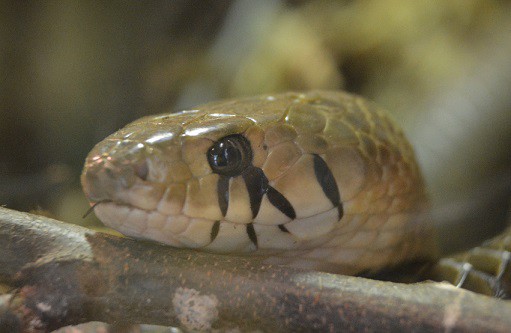
The central American relative of Florida’s eastern indigo snake. Central American indigo snakes (Drymarchon melanurus) are one of Guatemala’s longest snakes, blasting through the 2 metre mark and occasionally scraping to 2.4 metres.
This is an easily recognisable species, as they have one of the coolest eye markings of any snake: three thin markings spreading downwards with a colour of dense black. There’s also a 4th black line further back on the head, unconnected to the eye. These contrast vividly against its olive-yellow scales.
Likewise, its tongue is so black that it seems to have been drinking from a Texas oil well. Drymarchon melanurus mostly has a yellow body colour, with black colours beneath occasionally breaking through, but they darken towards the tail.
This snake has an extremely varied diet, featuring small mammals, bats, eggs, turtles and birds. This even includes the final frontier itself: the boa constrictor. This almighty showdown happened in February 2021, and the Central American indigo snake already had a firm grip on the smaller boa’s head when the scientists arrived. In response, the boa had coiled its body around its predator’s neck. Eventually, the Drymarchon melanurus and boa constrictor uncoiled and stared at each other, having reached a draw.
| 5 | Rhadinella xerophila |
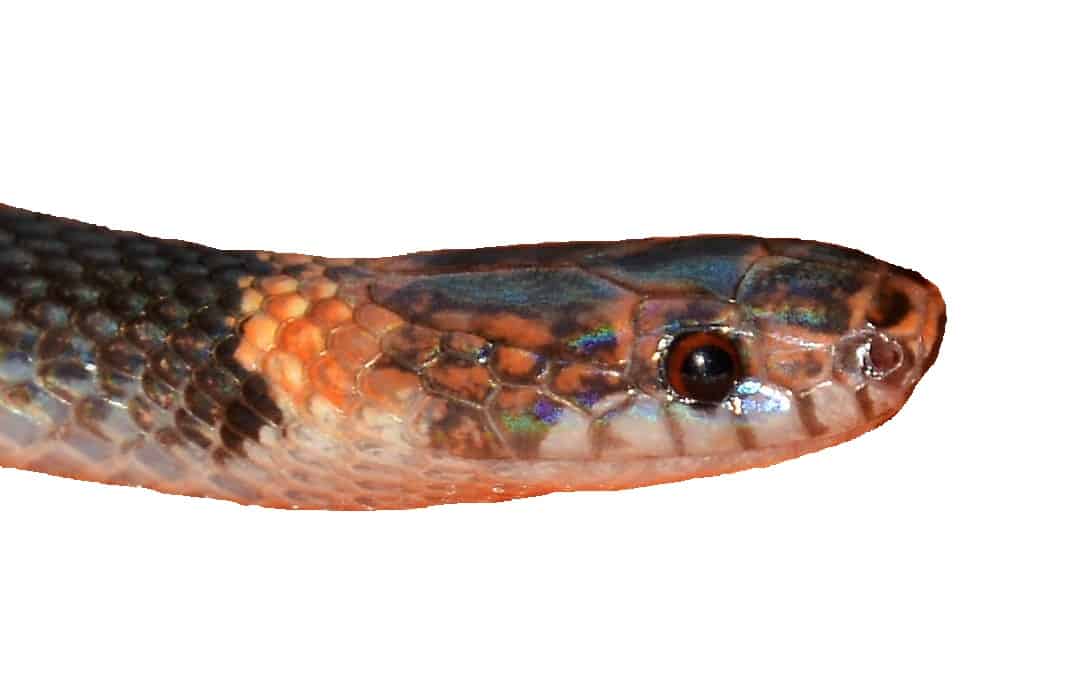
The newest addition to the Guatemalan snake crew. Rhadinella xerophila was discovered in 2016, in the dry forests and thorn scrub of Guatemala’s Motagua valley, an area which averages at 800mm of rainfall per year (versus 4000mm for the wettest rainforests). Like other Rhadinella family members, the snake had a white neck collar, but it differed from other members by its darker grey body colour, and the absence of noticeable stripes.
Rhadinella xerophila has a multicoloured head, with alternating scales of black and lava orange, like a path in a volcano starting to crack from below. Its scales have a slight iridescent sheen, and its tail is extremely long, tapering to a point. Its eyes have a round black pupil and a deep red iris. The original Rhadinella xerophila was found in Heloderma Natural Reserve, a privately owned nature paradise, surrounded by corn fields and melon crops.
The Rhadinella family has 20 members (this being the 20th), all in central America. All are non-venomous and all are short, ranging from 20-50cm. The new snake was found to be most closely related to Rhadinella pilonaorum, which also lives in Guatemala, only 90km to the southwest, in dry pine-oak habitats.
| 6 | False fer-de-lance |
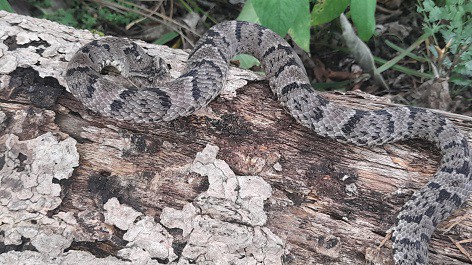
A mildly venomous snake which reaches 102cm at the most. This frog-eating species has placed its survival cards in the mimicry basket, copying the extremely venomous fer-de-lance that lives nearby. It does a decent job, with contrasting brown and beige patterns with the correct shades. They also get the triangular head correct. Yet this copycat falls down terribly with its pupils: cute and round rather than savage and vertical.
Nevertheless, its strategy must be working, as the false fer-de-lance (Xenodon rhabdocephalus) has managed to conquer every central American country. They inhabit Costa Rica, Panama and Guatemala alike, even reaching central Brazil. This is one of the more widespread snakes that barely any Westerners have heard of.
Xenodon rhabdocephalus is a dietary specialist, gathering calories from toads, frogs and their tadpoles. Consequently, they usually hang out close to streams, but those streams can be in a variety of habitats, including forests, fields and scrubland. In Guatemala, they appear at altitudes from sea level to 1200 meters.
As for their own venom, a Xenodon rhabdocephalus bite won’t take down a fully grown human, but the worst cases can cause intense pain and profuse bleeding. They also have a flexible upper jaw, which can rotate to position their rear fangs pointing outwards, allowing easier access to the human hands and fingers they target.
| 7 | Blunt-headed tree snake |
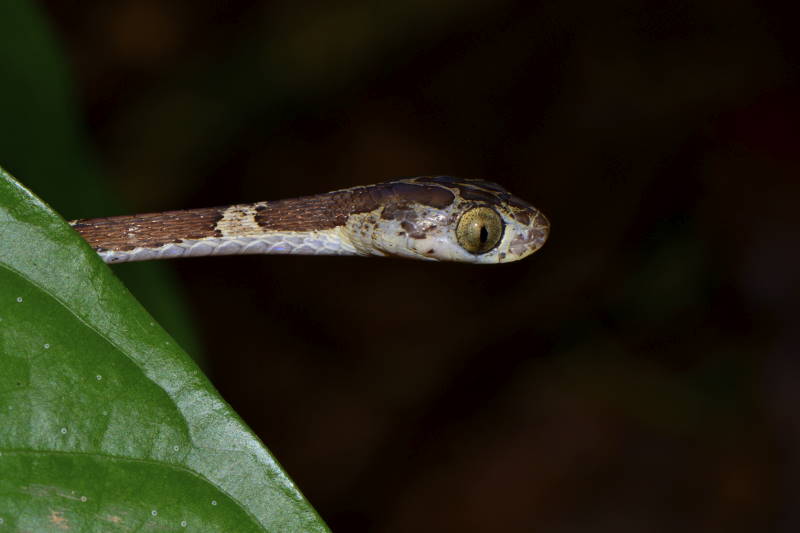
Firstly, the blunt-headed tree snake has extremely large, bulbous eyes, which enable binocular vision and seeing every inch of the forest floor simultaneously. Their body is the width of a twig, enabling them to cross chasms between branches 50% of their own body length. They measure 100cm (max 150cm), but are extremely light, preventing even the thinnest branches from snapping. Blunt-headed tree snakes also have sideways-projecting shelves on their vertebrae, to create stability while on branches.
This snake mostly eats reptiles, and is mildly venomous. Their huge eyes aren’t just for show, but give them extremely sharp eyesight. Blunt-headed tree snakes can spot lizards resting completely motionless on branches, even after they’ve been sleeping for 90 minutes. Meanwhile, most other snakes require movement to activate their hunting instincts. This species inhabits the vast majority of Guatemala, alongside an easily confused cousin, Imantodes gemmistratus.
| 8 | Mexican burrowing python |
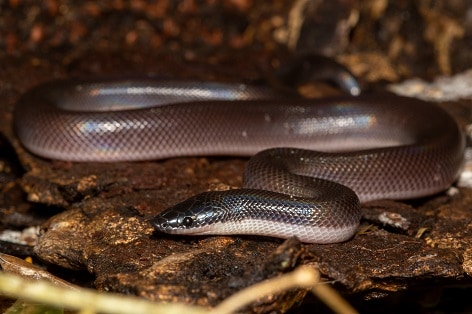
An expert burrowing snake, which hugs the Pacific coast of several central American countries. The Mexican burrowing python (Loxocemus bicolor) is a chocolatey brown species with beady black eyes that reaches 1.57 metres at the most. They can be found in dry lowland habitats, but also beaches, thanks to their digging tactics which allow them to delve deep into soft sand and away from harm.
This species is an evolutionary anomaly: the sole member of its Loxocemus genus, believed to have diverged from other snakes tens of millions of years ago. They’re also a long-lived species which doesn’t even begin reproducing until age 10, laying 10-15 white eggs when they do.
Turtles are one confirmed prey, including Olive Ridley sea turtles and their eggs. Loxocemus bicolor actually digs its own route into the underground egg chambers rather than using existing tunnels made by crabs. Once they’ve finished swallowing, they don’t reverse out, but their burrowing is so effortless that they simply continue forward and make a new route. To eat the eggs, they wrap around three coils and squeeze, causing the golden yolk to burst free. This species lacks venom, and it’s perfectly safe to touch them.
| 9 | Godman’s montane pitviper |
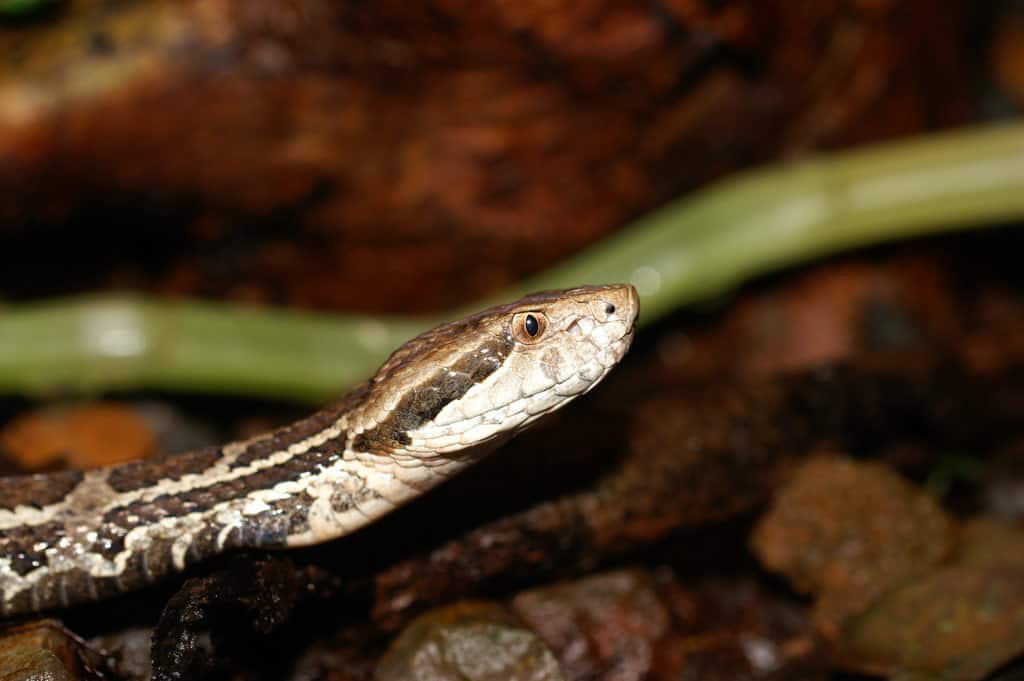
A venomous snake of misty mountain areas. Godman’s montane pitvipers (Cerrodiphion godmani) are most often seen crawling slowly along high altitude forest paths, surrounded by leaves and twigs. They’re one of the smaller vipers in Guatemala, at an all time record of just 82.2cm. This is actually an adaption to their cool mountainous climates, as a smaller body means a smaller total area to keep warm. Despite being short, they have a bulky body, and it’s rare for them to climb thin tree branches, with a low bush being the limit.
Godman’s montane pitviper has a flexible diet, including brush mice, spiny lizards, and climbing salamanders alike. Their venom overwhelmingly specialises in anticoagulant dangers, disrupting blood clotting and causing spontaneous bleeding from the slightest cut.
A study on 16 pitviper species found that its venom inhibited clotting in the classic way – cleaving through fibrinogenin bonds, the bloodstream’s main clotting agent. However, it also strongly decreased a second, less commonly targeted clotting agent called Factor Xa (FXa). All other pitvipers tested decreased Fxa only weakly, except for its Honduran cousin Cerrophidion wilsoni.
Godman’s montane pitviper is found in extreme southern Mexico, a large swathe of Guatemala, and western El Salvador. In Honduras, they’re suddenly replaced by their cousin Cerrophidion wilsoni, which is itself replaced by Cerrophidion sasai in Costa Rica and Panama.
| 10 | Guatemalan palm-pit viper |
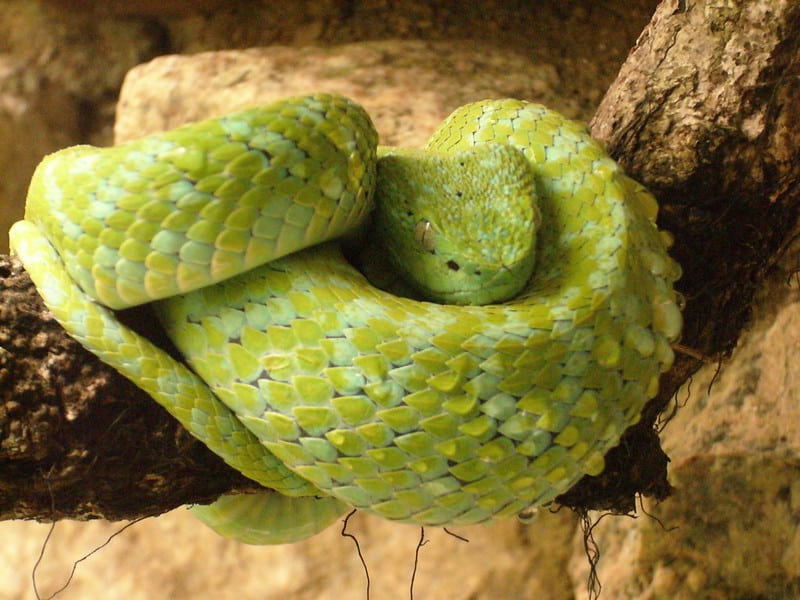
A venomous snake with a narrow, mountainous territory. Guatemalan palm pitvipers (Bothriechis bicolor) exist in just two countries: extreme southern Mexico and western Guatemala. This is a bright green serpent, with some scales almost having blue tinges. They’re strongly reliant on forests and average at 60-70cm, maximum 100cm. Compared to other pitvipers, their body is slender, allowing them to easily climb trees.
Bothriechis bicolor was once believed to live in isolated pockets in Honduras, but the sightings probably belonged to a different Bothriechis species. Instead, it solely exists in a narrow finger of mountain range in far southern Mexico, stretching over the border into south central Guatemala, and reaching 2090 metres above sea level.
Little is known about this species’ venom, though it’s assumed to cause mainly local symptoms. This snake may be vulnerable to extinction, as deforestation is rife in their mountainous regions. Guatemalan palm pitvipers cannot switch to open fields or scrubland; they need forest to survive. Coffee plantations are the most adventurous they get, but here, fearful farmers usually kill them on sight.
Consequently, many local populations of Bothriechis bicolor have vanished. They’re officially tagged as “least concern” by IUCN, but a 2020 study recommended an upgrade to “vulnerable”.
